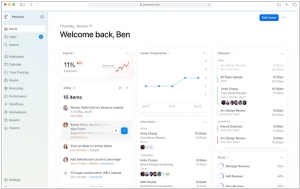Amazon Honeycode vs AppSheet
January 27, 2025 | Author: Michael Stromann
1★
Build a better way to work. You need to manage your tasks, your projects, and your team. Now you can build an app to achieve your goals with Amazon Honeycode. No programming required.
12★
Google's AppSheet provides a no-code development platform for application software, which allows users to create mobile, tablet, and web applications using data sources like Google Drive, DropBox, Office 365, and other cloud-based spreadsheet and database platforms.
Amazon Honeycode and AppSheet, despite their rather unassuming names, are two peculiar and cunning platforms in the vast galaxy of business app development, each with their own quirks and charms, rather like two rival interstellar hitchhikers trying to outsmart each other on the galactic highway.
Amazon Honeycode, which hails from the all-consuming mega-brain that is Amazon Web Services (AWS), takes the rather optimistic view that you shouldn’t have to write code to build an app. Armed with nothing but a visual application builder, users are gently nudged into creating simple, database-driven apps with all the elegance of an intergalactic hyperspace bypass. It’s perfect for businesses that have already pledged their souls to the AWS ecosystem and need to cobble together some functional apps without worrying too much about the pesky intricacies of code. The whole affair is charmingly straightforward and integrates neatly with AWS services, because, of course, resistance to the Amazonian way is futile.
Meanwhile, AppSheet, which now answers to the higher-ups at Google Cloud, operates on a slightly more sophisticated level, offering a platform that caters not only to those who quake at the thought of code (the no-coders) but also to those who quite enjoy the thrill of tinkering with it (the low-coders). AppSheet is a bit like a galactic hitchhiker with a well-worn towel—adaptable, flexible and ready for just about any data integration you throw at it. Its advanced customization options make it the preferred choice for those who want more out of their apps than the standard “press button, receive app” experience.
In the end, choosing between the two is rather like deciding whether to hitch a ride with the Vogons or the Betelgeusians—much depends on whether you're already entrenched in AWS or Google Cloud, how complicated your app needs to be and what kinds of galactic integrations you’re hoping to achieve. Either way, just don’t forget your towel.
See also: Top 10 Low-Code Platforms
Amazon Honeycode, which hails from the all-consuming mega-brain that is Amazon Web Services (AWS), takes the rather optimistic view that you shouldn’t have to write code to build an app. Armed with nothing but a visual application builder, users are gently nudged into creating simple, database-driven apps with all the elegance of an intergalactic hyperspace bypass. It’s perfect for businesses that have already pledged their souls to the AWS ecosystem and need to cobble together some functional apps without worrying too much about the pesky intricacies of code. The whole affair is charmingly straightforward and integrates neatly with AWS services, because, of course, resistance to the Amazonian way is futile.
Meanwhile, AppSheet, which now answers to the higher-ups at Google Cloud, operates on a slightly more sophisticated level, offering a platform that caters not only to those who quake at the thought of code (the no-coders) but also to those who quite enjoy the thrill of tinkering with it (the low-coders). AppSheet is a bit like a galactic hitchhiker with a well-worn towel—adaptable, flexible and ready for just about any data integration you throw at it. Its advanced customization options make it the preferred choice for those who want more out of their apps than the standard “press button, receive app” experience.
In the end, choosing between the two is rather like deciding whether to hitch a ride with the Vogons or the Betelgeusians—much depends on whether you're already entrenched in AWS or Google Cloud, how complicated your app needs to be and what kinds of galactic integrations you’re hoping to achieve. Either way, just don’t forget your towel.
See also: Top 10 Low-Code Platforms





